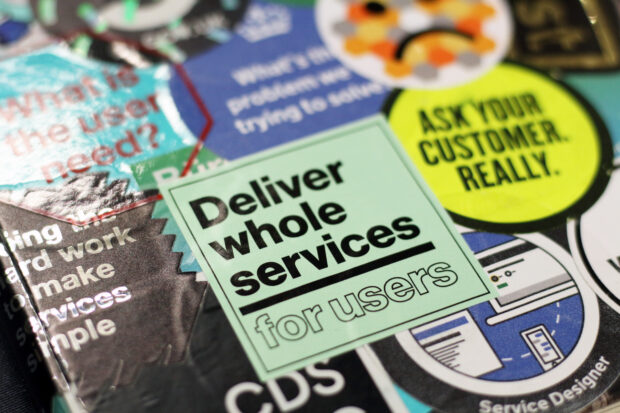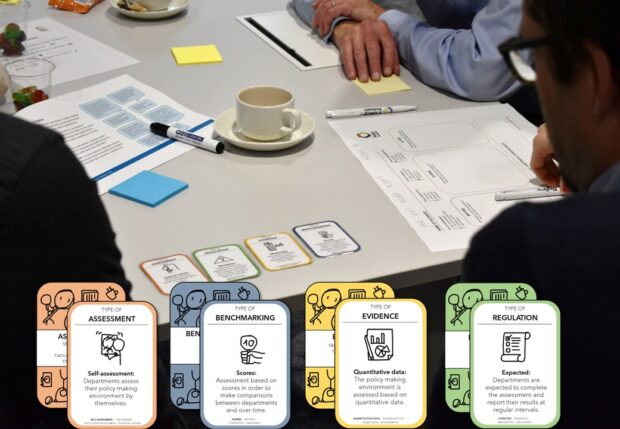
Before making any big design decisions for changing the services we operate, it’s helpful to explore different options and their potential benefits and trade-offs.
We - a multidisciplinary team based inside the UK Government’s Policy Profession Unit - are developing a model that can help government departments better understand their policy-making environment. It aims to identify best practice and areas for improvement.
Over summer last year we tested a first prototype of this model with policy makers at a central government department and from that we needed to make some design decisions based on our learnings and research. To help us, we introduced ‘scenario building’ to our design workshops with senior stakeholders.
What is scenario building?
A scenario is a story that illustrates a possible, alternative future - or aspects of it. Sometimes we can become too familiar and comfortable with the way things are. We can find it hard to think ‘outside the box’.
Scenario building is an exploratory activity that helps widen the perspective of stakeholders by getting them to visualise different design decisions and their consequences.
It was the first time our team did scenario building in a workshop. It was also a bit of an experiment for us.
Preparing for scenario building
Participants included key project stakeholders, policy makers from the department where we’d tested the model and subject matter experts.
We had a large journey map printed out, representing the process we had designed and tested in the summer. We started by talking participants through it to familiarise participants with the current ‘as-is’ scenario of what the experience is like for someone going through the process. It served as a common knowledge base and collective frame of reference later in the workshop.
We discussed specific moments in the journey that they identified as being a potential challenge or an opportunity for change, for example how the process would be initiated or how we might reduce steps.
Design rule cards as stimulators

Next, we gave every group a set of 4 design rule cards and a template to document their future scenario. We asked them: how might the process and user experience change if the design rules you’ve been given come into play?
Design rules represent choices that have been made - for example, what would the model look like if it was a mandatory process, as opposed to a voluntary process or a rewarded process? They are not necessarily positive or negative, good, or bad. Instead, they present us with a spectrum of different ‘extreme’ design requirements.
The participants were not only asked to discuss their design rules but to envision what their scenario would look like and what unintended consequences might arise.
For example, in the last workshop we ran the design rules included:
- Types of assessment - for example self assessment, where departments would assess the policy making environment by themselves
- Types of benchmarking - for example scores, where departments are assessed based on scores in order to make comparisons between them over time
- Types of evidence, for example using quantitative data, where the policy making environment is assessed based on data
- Types of regulation, for example expected, where departments are expected to complete an assessment and report their results at regular intervals
Helping to engage stakeholders in design decisions
We were positively surprised about how open and willing our participants engaged in this activity. Once a scenario had been described, participants immediately started looking for new, different solutions.
The groups presented their scenarios to each other, looking at the following questions:
- What opportunities and challenges does the alternative scenario present?
- What might be unintended consequences of the scenario?
- What could this mean for the design of our model?
The result was not just a variety of different scenarios based on different design rule cards, but also a first sense of how changing a rule in the design can change the whole experience for the user, creating new, unintended consequences - both positive and negative. It helped our stakeholders to interrogate their own assumptions and think through the practicalities of a particular approach, as well as stretch their imaginations.
We found scenario building a really helpful tool for engaging meaningfully with stakeholders on a complex topic. It allows people to look at things from a user point of view and to explore the potential impact of their interventions or ideas.
We also found it very powerful in conveying the core of an idea and making it comprehensive in a short 5-minute presentation. Normally, a scenario fits on one page, which allows people to quickly digest it and discuss it.

Applying scenario building in your work
Here are some tips for implementing scenario building in your work:
- Collaborate with your team: Who has an interest or knowledge of your product or service and should be involved in the scenario building activities?
- Map your current as-is scenario (or journey map): What does the current experience of your users look like using your product or service?
- Define your design rules: What are existing (or non-existing) requirements of your system, in which your product or service has to be developed and delivered?
- Explore future scenarios: How might your product or service look different applying different combinations of design rules?
- Reflect on your scenarios: What insights have you gained from those scenarios?
